Source: Der Spiegel Online, article “Aufmarsch der Gummiarmee” by Christoph Gunkel (20.4.2010)
Originally sent to me and translated by Muff99 (EU server), thank you
Video: (English) http://www.spiegel.de/video/video-1061212.html
After D-Day, a top-secret U.S. special unit went to war without any protection but inflatable tanks and trucks to lay traps for the Wehrmacht.
Even today this “ghost army” is still a mystery: Did they rescue tens of thousands of lives – or did they fool their own troops?
The two French civilians could not believe their eyes. In September 1944, they were stopped by U.S. soldiers at the border to Luxembourg. The GIs asked suspiciously what they wanted here, but the French hardly listened. For what they saw behind the patrol, left them speechless:
Four U.S. soldiers walked towards a Sherman tank, bent down, lifted the tank effortles, turned it around and put it down again.
Those Americans had neither used magic portions nor superhuman powers – the tank did not weigh more than 40 kilograms, since the “iron beast” was entirely made of rubber. The french civilians had accidently caught a top secret U.S. unit at work – the “23 Headquarters Special Troops.” This unusual unit was internally called “The Ghost Army” or “The Rubber Army”, since almost everything was inflatable: Artillery, planes, tanks, jeeps, trucks. The “ghost army” was meant to fool the Germans in believing that their 1100 soldiers looked more 30,000. This was one of the almost completely hidden attempts to win battles without firing a single shot.
Hours of tank inflating
“Never, under any circumstances, should we lift a tank and carry it over the street”, says Jack Masey under a laughter. “That could have given us away.” The now 85-year veteran from New York was responsible for the maintenance of the rubber arsenal – knowing that this rule was ignored quiote often. “For every maneuvers we had to let out the air, to pack everything into backpacks and inflate them again elsewhere.” Too laborious, too time-consuming – especially when there was no compressor available. Sometimes, as reported by Masey, the soldiers had to use bike pumps or use their lungs for hours to re-inflate the tanks.
What sounds like Hollywood was the way of World War II, which was also a battle of the intelligence services. Misleading messages, false trails and manipulated documents were used by all sides alike. In May 1940 the Germans successfully hid the fact that their focus of attack was on France – this way winning the campaign against France, breaking through the front near Sedan.
The British in turn duped General Erwin Rommel in North Africa, being a master of feints himself. They disguised tanks as trucks and trucks as tanks or deceived the german aerial reconnaissance with decoys of airfields. Before the D-Day 1944 the British emlated whole nion-existing divisions by using extensive radio communications. This legendary “Operation Fortitude” was one of the reasons rwhy the Wehrmacht believed that the invasion would take place at Pas-de-Calais – and not in the Normandy. In war, truth needa “a bodyguard of lies” as Winston Churchill remarked proudly after this coup.
To date, however, its almost unknown to the public that the U.S. Army operated by such methods even months after D-Day. The “ghost army” was so secret that many veterans didnt want to talk about it for decades. Official U.S. documents were not released until the mid-nineties, and literature on the subject is rare.
Army of artists
Fascinated by the incredible history of this forgotten tale, the Americans Rick Beyer is researching witnesses and documents for over two years now. He wants to make a documentary about this army, that fought by peaceful methods – and possibly saved the lives of 40,000 soldiers by deceiving the Wehrmacht and prevented them from attacking …. according to U.S. journalist Jack Kneecem, who published this estimates in his book “Ghost Army of World War II”.
Historian John Zimmermann of the Military History Research Institute in Potsdam has serious doubts with those: “The German war reports did not contain any indications that the Wehrmacht knew something of such an army or the ghost army had an impact on German war effort.” Was the camouflage a little too perfect? Were the maneuvers ultimately ineffective? This remains unknown: By the end of 1944, the germans were almost unable to fly aerial reconnaissance, argues Zimmermann. The use of dummies therefore really does not make much sense.
For Jack Masey this surreal army became realty quite quickly when the army called him in in 1943 shortly after the 18-year-old was admitted to the prestigious High School for Music and Art in New York. Now the military wanted to benefit from his creativity.
The “ghost army” recruited sound engineers, illustrators, photographers, actors and other creative people. Some became famous later on, like the painter Ellsworth Kelly or fashion designer Bill Blass, who bcame friends with Masey in his unit, the “603D Engineer Camouflage Battalion”. Masey made good careeer after the war, too: He designed museums and coordinated the building of pavilions at the World Expo for the U.S. government.
Vulnerable to war
The United States started training their first artist warriors in a conventional way, then the recruits were sent to England. The British had experience with the use of false weapons of war and finalised their training. For weeks, the soldiers not only crawled through ditches or practiced assaults – but also created harmless dummies until they looked real by a distance of 100 meters.
A few weeks after D-Day, most of “ghost army” companies were shipped to France. “It was all pretty calm,” Masey reports on his arrival at the legendary Omaha Beach, where the Allies landed on June 6, 1944. “But I still was afraid. We were in the midst of war – using nothing more than inflatable weapons. And our task was to draw enemy fire on us.”
For in their total of 21 operations,the “ghost army” followed the same procedure. They took the role of various divisions of the 12th U.S. Army, which really existed. In this way, scope for surprise attacks presented themselves. The false army units should keep German forces buy and distract from the true focus the maneuvers.
This was a dangerous undertaking: If they would have been uncovered, the pseudo-army would be defeated instantly. Although they had several trucks and sometimes even a real tank – which left track marks as visible as possible. But the soldiers were neither battle-tested nor equipped for war. “For our defense we only had our standard rifle,” says Jack Masey. “That was all.”
Too good a deception
The dummy army truested their own smart weapons, which got applied at nightfall. Huge speakers roared noise, simulating a flurry of activity: Moving tanks, braking trucks, loud and many voices. Light and sound effects simulated artillery fire. Half-tracks left behind many tank tracks in the dust. Massive radio communications, often unencrypted, was used to simzulate powerful divisions.
Its difficult to assess how well those operations worked out. At least sometimes the Germans fired repeatedly in the direction of speakers and dummies or reinforced their troops for defense. The deception worked so well that even U.S. units who did not know of a nearby “ghost army”, got confused. A U.S. Major asked soldiers where all his vital tanks were that he heard at night – and couldnt find at day.
Jack Masey, however, did not unconditionally trust his own camouflage work. On one of his first missions near the coastal city of Brest, his company got fired at. But not nearly as strong as he would have expected. “It looked as if the Germans would have seen through everything, but did not take us seriously.”
There was another reason why “Operation Brest” was not a success. The deception was indeed “outstanding,” as praised by an internal report later on. But “unfortunately” a unit of the “ghost army” made the Germans believe an attack was imminent at a place where shortly after the real divisions were attacking. The Americans lost nearly ten thousand men during the storming of the fortress.
Trick at the Rhine
For Jack Masey, it was a bizarre, bloodless war. Overall, only two soldiers of the “ghost army” were killed by German attacks, confirms journalist Kneece. No unit lived safer, after all, a direct front line manouever was impossible. Therefore the GIs played a kind of professional theater most of the time. They tried to outwit potential Nazi collaborators and spies. They drove to the cities, talked to locals, went to bars, scattered rumors – always wearing the army badges for the division they tried to fake, changing the markings on their army jeeps accordingly.
They joked about living a constant identity crisis, pointing at the fake badges. For fun some of the artists designed their your own logo, which of course was never allowed to be used, featuring a ghost with lightning emerging from its hands. Below the mottot: “Lets pretend those that do not exist”
The biggest success was their final operation. Near Viersen, tehy used almost the entire arsenal of inflatable dummies at once in March of 1945. An army of 600 rubber tanks and artillery faked an assault across the river Rhine. Even roadworks sounds of pontoon bridges were imitated. In fact, the Rhine-attack happened on March 23 further north near Wesel. Perhaps the Allies encountered only little resistance because the “ghost army” had previously bound German units in the south.
Only after this last operation Jack Masey experienced the true horrors of war. In Germany he met emaciated civilians, forced laborers and refugees. An image burned into his memory, which he perceived as a symbol of the lack of culture of war: In the devastated Aachen, he saw hundreds of tattered books near a bombed library rotting in the mud.
Relics of a war that for most of the time had been a unreal role-playing game for him.
For further reading: Jack Kneece: Ghost Army of World war II “, Pelican Publishing Company, 2001.

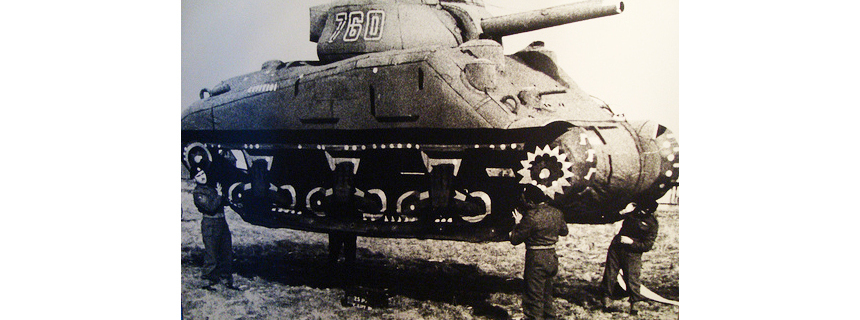
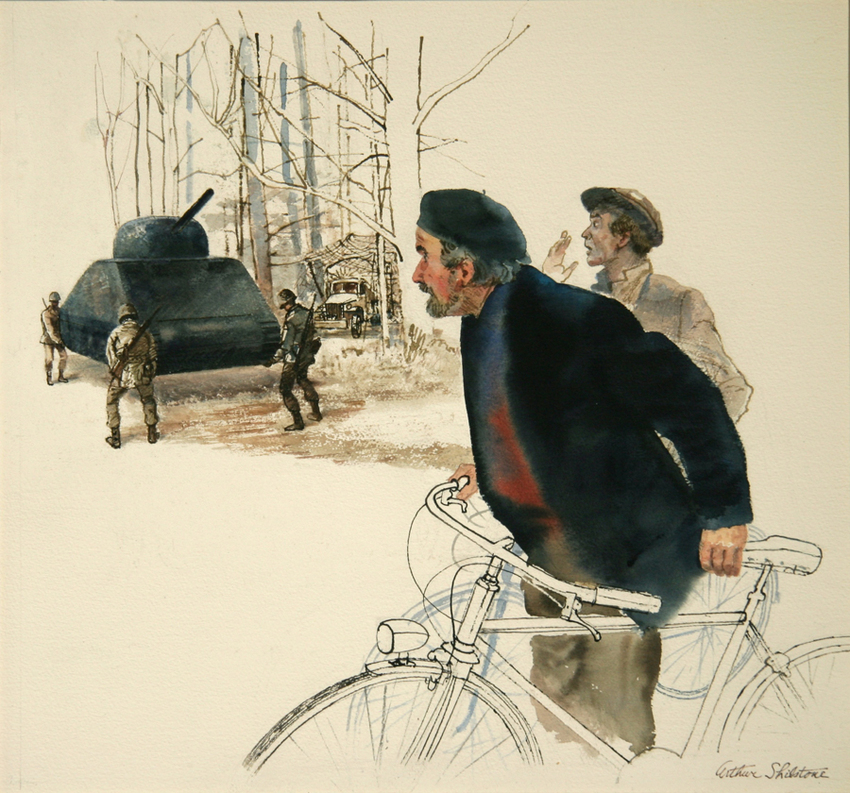
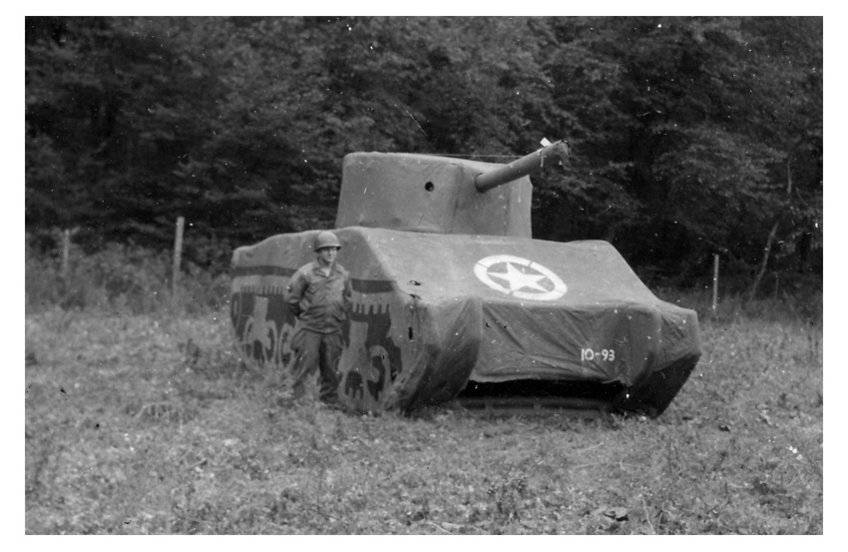
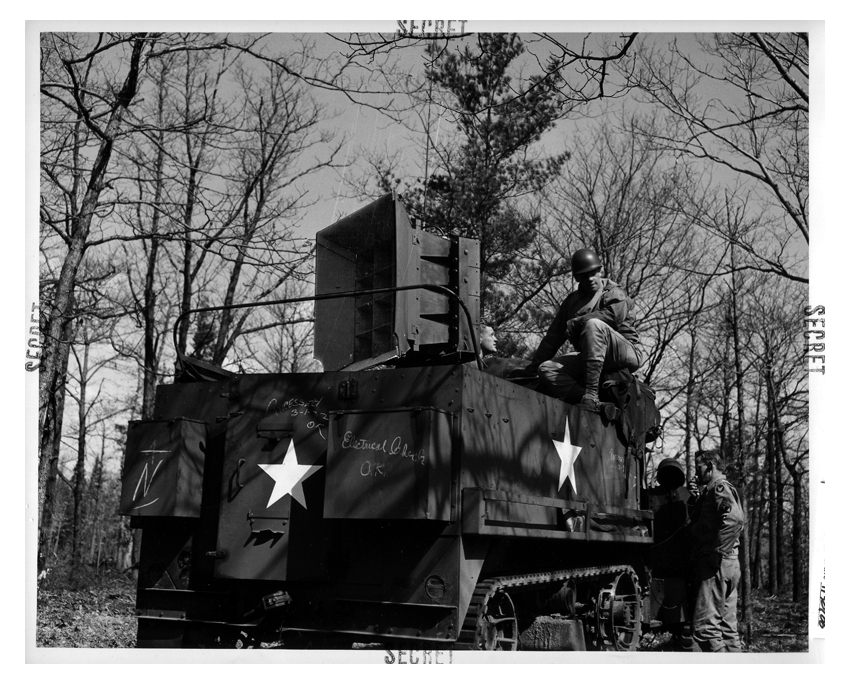
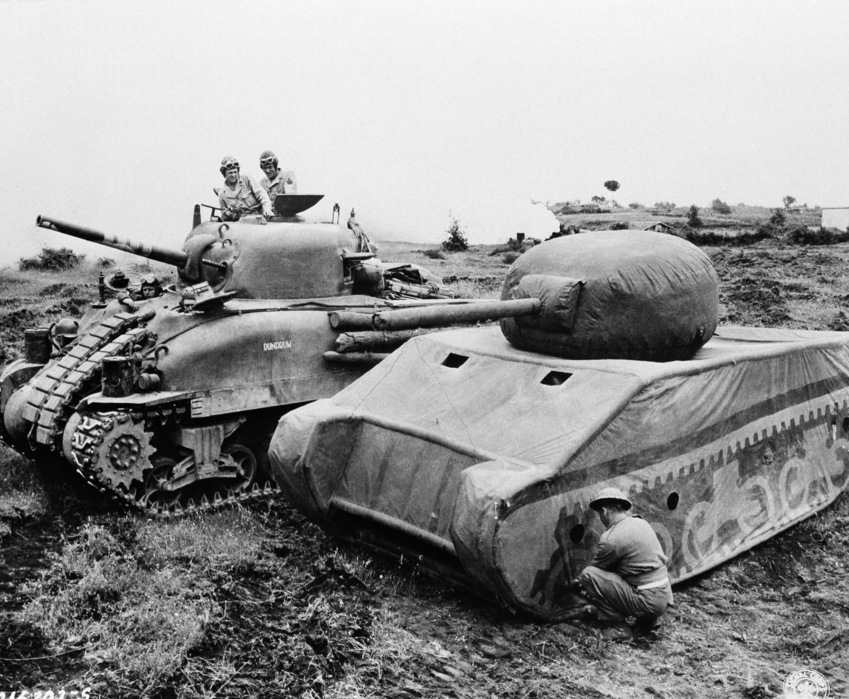
Not the first time armies used the dummies for deception. the prime examples where what the Desert Rats and Afrikakorps did to fool each other, like wooden tank mock ups on trucks, tanks disguised as trucks in return or special trailers to make Matilda thread marks.
>tanks disguised as trucks
wat :D ?
http://www.youtube.com/watch?v=_bSEfx6D8mA <—British tank crew after discarding their tank's disguise in combat.
Though really, it’s true. Matildas, Valentines, and Crusaders were at times disguised as trucks during the Africa Campaign.
http://www.nationalarchives.gov.uk/education/worldwar2/theatre-assets/western-europe/deception/photos/wo-201-2841.jpg
Imagine the looks on the Germans’ faces when they saw that a defenseless target wasn’t so defenseless at all. :>
reminds me of the joke about a certain Soviet tractor… :D
“On USSR-China border, five chinese tanks attacked a soviet tractor. The tractor returned fire, and after it destroyed all attackers, it flew back to the USSR.” :D
there is an artist who depicted the joke: http://roen911.deviantart.com/art/mean-while-in-soviet-Russia-336200056 :D
Ayep XD If you want i can scan photos of all three examples form my mini book on El Alamein :P
Not first, when Rommel arrive to north Afrika he uses Volkswagen to made dust and force an UK garrison leave the occupy italian fort.
Not a strategic use of fakes, a tactical use but fake to hehehe.
I still prefer the one where the British hid the Suez Canal and make a fake on a couple of miles away.
They hid the City of Alexandria. The Suez they just blinded anyone stupid enough to fly near it.
There is a movie on this “Ghost Army”.
Google “The Ghost Army”.
http://en.wikipedia.org/wiki/The_Ghost_Army_(film)
It’s more like a documentary, really.
Good article, i was not aware of this unit untill now.
Today the the msot advanced dummies are used by the Russian Federation armed forces. They shared some of their knowledge and equipment with Serbia just prior to the last Nato bombings. According to the Serbs the deceptions where very effective at attracting fire from NATO fighters/bombers and cruise missiles.
Can you imagine having to blow rubber tanks up using only your lungs? Damn, guys probably had oxygen uptake like racing horses by the end of the war…
Awesome read man. I can only imagine how tedious and hard to organize all that work was. And secretly!
And to think today we have satellites that will detect even well dug underground bunkers.
Considering the limitations of satellites and drones, it seems entirely possible that an Inflatable Army of sorts would still be possible.
I hope they wont be added in WoT…
Enhough tomatoes crying about no armor already…
But nice article, I want on of thoseXD
The ultimate light tank
Now we know where did the French got their idea to create an amx 40
More like the other way around, as the AMX 40 was designed before the war.
So a nice oddity with most likely no real value but the radio games. At least the British “Ghost Armies” pretending to wait for an attack on Calais delayed German intervention on the Invasion Beaches for several weeks.
But seriously, the part on Brest was silly. Especially the thing about “almost ten thousand lost” when the Allies barely lost four thousand. The City was well defended because the Germans weren’t idots, and had their share of supply lack experiences. They knew the Allies needed to take Harbour facilities, and that it was virtually impossible to attack the Brittany ports from the sea. Hence landward facing entrenchments.
The french built a fake, wooden Paris in 1916. That beats a couple plastic tanks IMO.